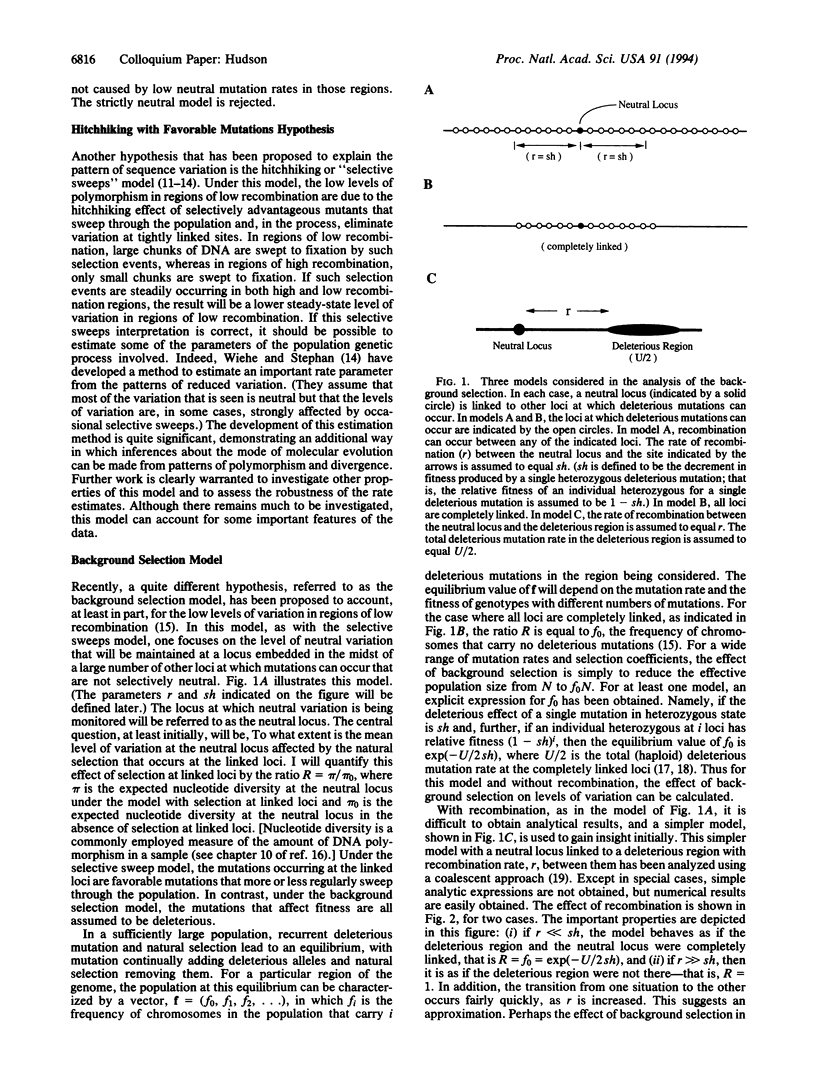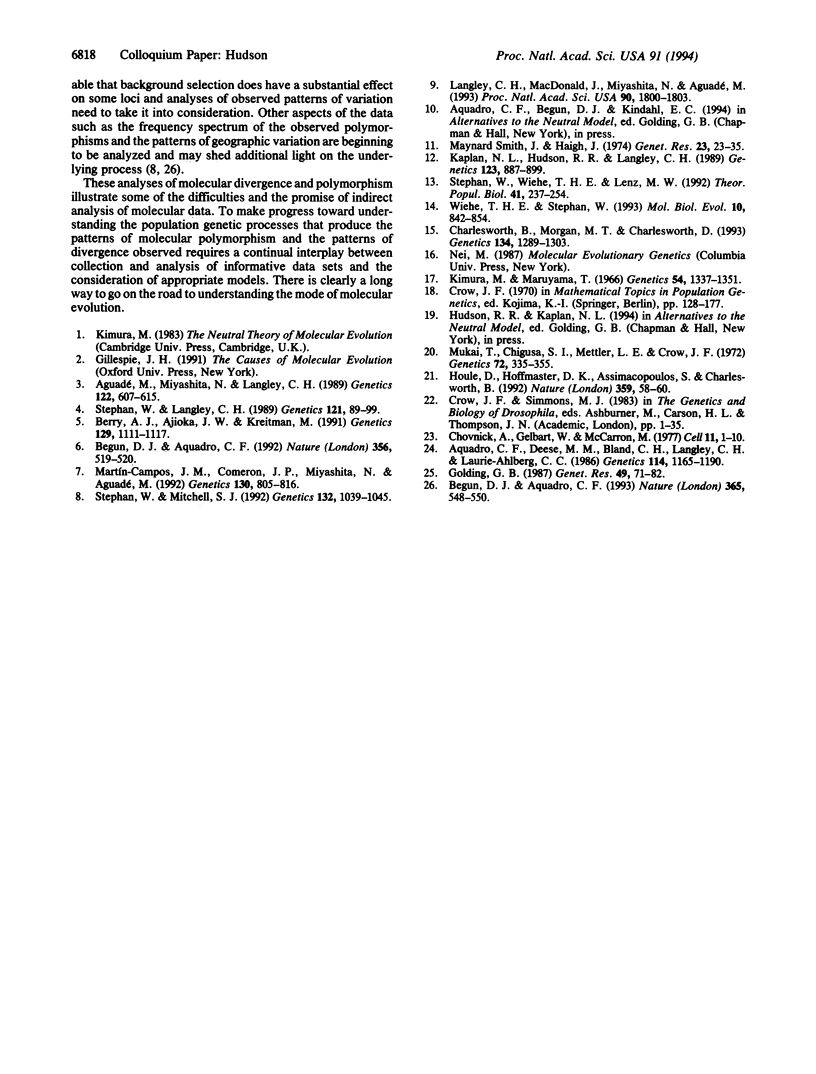Abstract
Different regions of the Drosophila genome have very different rates of recombination. For example, near centromeres and near the tips of chromosomes, the rates of recombination are much lower than in other regions. Several surveys of polymorphisms in Drosophila have now documented that levels of DNA polymorphism are positively correlated with rates of recombination; i.e., regions with low rates of recombination tend to have low levels of DNA polymorphism within populations of Drosophila. Three hypotheses are reviewed that might account for these observations. The first hypothesis is that regions of low recombination have low neutral mutation rates. Under this hypothesis between-species divergences should also be low in regions of low recombination. In fact, regions of low recombination have diverged at the same rate as other regions of the genome. On this basis, this strictly neutral hypothesis is rejected. The second hypothesis is that the process of fixation of favorable mutations leads to the observed correlation between polymorphism and recombination. This occurs via genetic hitchhiking, in which linked regions of the genome are swept along with the selectively favored mutant as it increases in frequency and eventually fixes in the population. This hitchhiking model with fixation of favorable mutations is compatible with major features of the data. By assuming this model is correct, one can estimate the rate of fixation of favorable mutations. The third hypothesis is that selection against continually arising deleterious mutations results in reduced levels of polymorphism at linked loci. Analysis of this background selection model shows that it can produce some reduction in levels of polymorphism but cannot explain some extreme cases that have been observed. Thus, it appears that hitchhiking of favorable mutations and background selection against deleterious mutations must be considered together to correctly account for the patterns of polymorphism that are observed in Drosophila.
Full text
PDF



Selected References
These references are in PubMed. This may not be the complete list of references from this article.
- Aguade M., Miyashita N., Langley C. H. Reduced variation in the yellow-achaete-scute region in natural populations of Drosophila melanogaster. Genetics. 1989 Jul;122(3):607–615. doi: 10.1093/genetics/122.3.607. [DOI] [PMC free article] [PubMed] [Google Scholar]
- Aquadro C. F., Desse S. F., Bland M. M., Langley C. H., Laurie-Ahlberg C. C. Molecular population genetics of the alcohol dehydrogenase gene region of Drosophila melanogaster. Genetics. 1986 Dec;114(4):1165–1190. doi: 10.1093/genetics/114.4.1165. [DOI] [PMC free article] [PubMed] [Google Scholar]
- Begun D. J., Aquadro C. F. African and North American populations of Drosophila melanogaster are very different at the DNA level. Nature. 1993 Oct 7;365(6446):548–550. doi: 10.1038/365548a0. [DOI] [PubMed] [Google Scholar]
- Begun D. J., Aquadro C. F. Levels of naturally occurring DNA polymorphism correlate with recombination rates in D. melanogaster. Nature. 1992 Apr 9;356(6369):519–520. doi: 10.1038/356519a0. [DOI] [PubMed] [Google Scholar]
- Berry A. J., Ajioka J. W., Kreitman M. Lack of polymorphism on the Drosophila fourth chromosome resulting from selection. Genetics. 1991 Dec;129(4):1111–1117. doi: 10.1093/genetics/129.4.1111. [DOI] [PMC free article] [PubMed] [Google Scholar]
- Charlesworth B., Morgan M. T., Charlesworth D. The effect of deleterious mutations on neutral molecular variation. Genetics. 1993 Aug;134(4):1289–1303. doi: 10.1093/genetics/134.4.1289. [DOI] [PMC free article] [PubMed] [Google Scholar]
- Chovnick A., Gelbart W., McCarron M. Organization of the Rosy locus in Drosophila melanogaster. Cell. 1977 May;11(1):1–10. doi: 10.1016/0092-8674(77)90312-9. [DOI] [PubMed] [Google Scholar]
- Golding G. B. The detection of deleterious selection using ancestors inferred from a phylogenetic history. Genet Res. 1987 Feb;49(1):71–82. doi: 10.1017/s0016672300026768. [DOI] [PubMed] [Google Scholar]
- Houle D., Hoffmaster D. K., Assimacopoulos S., Charlesworth B. The genomic mutation rate for fitness in Drosophila. Nature. 1992 Sep 3;359(6390):58–60. doi: 10.1038/359058a0. [DOI] [PubMed] [Google Scholar]
- Kaplan N. L., Hudson R. R., Langley C. H. The "hitchhiking effect" revisited. Genetics. 1989 Dec;123(4):887–899. doi: 10.1093/genetics/123.4.887. [DOI] [PMC free article] [PubMed] [Google Scholar]
- Kimura M., Maruyama T. The mutational load with epistatic gene interactions in fitness. Genetics. 1966 Dec;54(6):1337–1351. doi: 10.1093/genetics/54.6.1337. [DOI] [PMC free article] [PubMed] [Google Scholar]
- Langley C. H., MacDonald J., Miyashita N., Aguadé M. Lack of correlation between interspecific divergence and intraspecific polymorphism at the suppressor of forked region in Drosophila melanogaster and Drosophila simulans. Proc Natl Acad Sci U S A. 1993 Mar 1;90(5):1800–1803. doi: 10.1073/pnas.90.5.1800. [DOI] [PMC free article] [PubMed] [Google Scholar]
- Martín-Campos J. M., Comerón J. M., Miyashita N., Aguadé M. Intraspecific and interspecific variation at the y-ac-sc region of Drosophila simulans and Drosophila melanogaster. Genetics. 1992 Apr;130(4):805–816. doi: 10.1093/genetics/130.4.805. [DOI] [PMC free article] [PubMed] [Google Scholar]
- Mukai T., Chigusa S. I., Mettler L. E., Crow J. F. Mutation rate and dominance of genes affecting viability in Drosophila melanogaster. Genetics. 1972 Oct;72(2):335–355. doi: 10.1093/genetics/72.2.335. [DOI] [PMC free article] [PubMed] [Google Scholar]
- Smith J. M., Haigh J. The hitch-hiking effect of a favourable gene. Genet Res. 1974 Feb;23(1):23–35. [PubMed] [Google Scholar]
- Stephan W., Langley C. H. Molecular genetic variation in the centromeric region of the X chromosome in three Drosophila ananassae populations. I. Contrasts between the vermilion and forked loci. Genetics. 1989 Jan;121(1):89–99. doi: 10.1093/genetics/121.1.89. [DOI] [PMC free article] [PubMed] [Google Scholar]
- Stephan W., Mitchell S. J. Reduced levels of DNA polymorphism and fixed between-population differences in the centromeric region of Drosophila ananassae. Genetics. 1992 Dec;132(4):1039–1045. doi: 10.1093/genetics/132.4.1039. [DOI] [PMC free article] [PubMed] [Google Scholar]
- Wiehe T. H., Stephan W. Analysis of a genetic hitchhiking model, and its application to DNA polymorphism data from Drosophila melanogaster. Mol Biol Evol. 1993 Jul;10(4):842–854. doi: 10.1093/oxfordjournals.molbev.a040046. [DOI] [PubMed] [Google Scholar]


